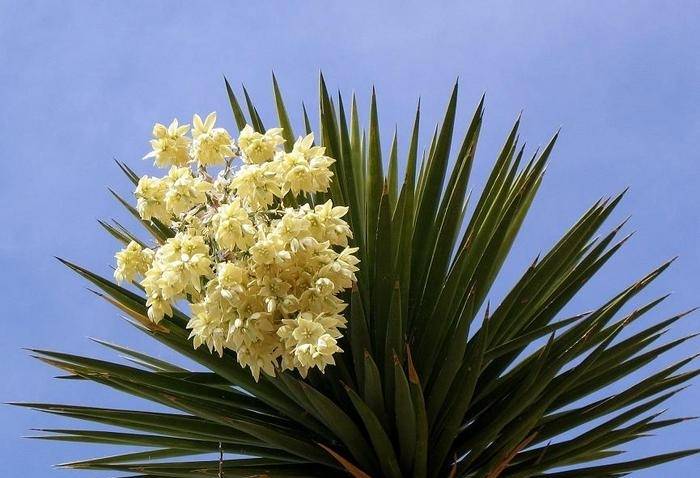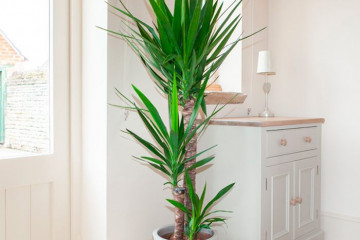Why yucca does not bloom - possible reasons
Content:
Yucca is a fairly popular plant with a thick trunk and a cap of long green leaves. It can often be found in houses and apartments. However, the culture can also be used to decorate garden plots, and under good conditions, many manage to see beautiful flowers and feel how yucca smells. But often the owners have a question why the yucca does not bloom. There are several reasons provoking this plant condition.
What varieties and when does yucca bloom
Yucca (lat. Yucca) - palm tree, belongs to the Agave family. Unfortunately, at home, the flowering of a houseplant is possible in very rare cases. However, this phenomenon looks quite impressive.
Basically, species that are used in landscape design bloom annually. There are more than 20 varieties with the same agricultural technology and care methods.
The most common are:
- Filamentous. In this species, the leaves have a blue-green tint, they can be up to 90 cm long, the top is sharp. There are threads along the edges that fall off after a while. Inflorescence - panicle, length from 1 to 3 meters. The flowers are 5 to 8 cm long, the shade is white, with an admixture of cream, green or yellow. After flowering, fruits are formed - a box with black seeds.
- Short-leaved. A tree with a height of 4 to 12 m. The top is lush, up to 90 cm in diameter. The size of the leaves can reach 35 cm. The inflorescence is a dense panicle with flower buds about 7 cm in size, greenish-white. The fruit is a capsule with black seeds.
- Sizaya. A widespread species, a small shrub, it grows up to 40 cm. The leaves are thin and long (up to 70 cm), there are thin threads around the edges that curl slightly. The peduncle can grow up to 3 m, the flowers are white, often with a green or yellow tint, up to 7 cm in size.
- Glorious. This species is represented by a shrub or tree up to 2.5 m high, can form several trunks. Leaves of a dark green shade with a bluish bloom, xiphoid, reach a length of 1 m. The inflorescence is a panicle up to 1.5 m high with white flowers that have a violet-red spot outside the perianth at the base.
These are the most popular species of the yucca plant and can be seen flowering with proper care and conditions every year.
What factors affect the flowering of yucca
Why doesn't yucca bloom and what to do to make it happen? It is a tropical plant and therefore needs to be provided with suitable flowering conditions.
Air humidity
Yucca is not demanding on high air humidity. However, some varieties do not tolerate drought well, so spraying is required periodically. The procedure is carried out in the morning or in the evening, but not in the afternoon.
Temperature regime
Palm is a heat-loving and sun-loving plant. It is better to plant the crop in an open and not shaded area. It is important to choose a location that is protected from drafts and not to place the yucca next to tall plants that will block out the light. Such conditions will negatively affect flowering, as well as poor-quality shelter for the winter.
By winter, collect all the yucca leaves in a panicle, tie.It is allowed to leave the flower without shelter, garden species can withstand quite severe frosts. The main thing is that in cold weather the central bud, which is responsible for flowering, does not suffer.
For domestic species in the winter, it is important to ensure the temperature is no higher than 10 degrees. Not always beginner growers understand why this is needed. However, otherwise the plant loses its attractive appearance, can get sick, and is often affected by pests.
Watering
Despite the fact that yucca belongs to tropical plants, it does not like too moist soil. Garden species need to be watered several times per season, a little more often in dry weather. Irrigation is carried out at the root, not from above. Home flowers are watered after the topsoil dries out at least 5 cm.
If the yucca lacks moisture, then this can be easily noticed by its appearance - the strings near the inflorescences will simply hang. At home flowers, leaves will begin to dry out and fall off.
Diseases and pests - as the cause of non-flowering
Diseases and pests disrupt the normal development of the flower, so it does not release flower stalks and does not bloom. Watering with cold water, constant drafts with cold air, excessive irrigation, damage to the root system are dangerous for the culture. As a result, yucca is affected by various types of fungal and bacterial diseases, due to which the plant may die.
The flower can infect such pests as scale insects, aphids, spider mites, mealybugs. The parasites develop rapidly on plants with weak immunity and spread to all parts. Noticing the presence of pests, it is required to immediately take the necessary measures - to treat the plant with soapy water, and then with special preparations with a chemical composition.
How to stimulate flowering
Many growers want to get flowers on a plant. There are several things you can do to make a yucca bloom:
- Be wary of the root system, because it is through it that the peduncle is formed - the roots cannot be poured, try not to damage when planting.
- In warm weather, a home flower should be taken outside so that it gains sun and strength. Small bushes will easily take root in the open field, and a three-year-old plant is capable of blooming.
- For yucca, it is important to periodically feed, they will also contribute to the appearance of a peduncle.
- If roots are visible from the drainage holes, then the culture should be transplanted, providing a more suitable container. In this case, the possibility of flowering will increase significantly.
Home specimens are very rare to please with flowering, so it is better to plant a yucca flower in open ground. After the peduncle dries, it must be cut off and the plant should be allowed to gain strength before wintering. If desired, even a house plant can be made to bloom by providing it with suitable conditions and proper care.


















